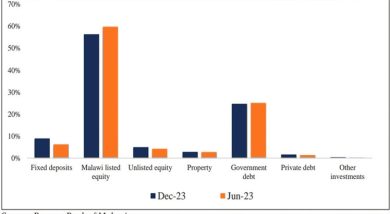MCCCI sees trade on recovery path
Malawi Confederation of Chambers of Commerce and Industry (MCCCI) says there is hope for economic and trade recovery as economies worldwide continue to open up due to the easing of Covid-19 cases.
MCCCI president James Chimwaza said this in the context of a recent World Trade Organisation (WTO) update indicating that trade on the global market is showing signs of recovery and projected to rise in the second half of the year.

In its Trade Statistics and Outlook update issued on Monday, WTO predicts global merchandise trade volume growth of 10.8 percent in this year, up from eight percent forecasted in March in view of resurgence of global economic activity.
Chimwaza said as economies are opening up, local businesses, which have suffered greater losses due to the global trade disruptions, are slowly picking up.
He said: “Malawi just as many countries in the region and worldwide, depend on other countries on trade.
“The lockdowns and travel restrictions implemented by countries in view of the Covid-19 pandemic saw the businesses struggling to access raw materials and other crucial commodities.”
Chimwaza said the private sector is pleased that things are pointing to a better outlook.
“We have seen trade fairly picking up and we hope this continues. This recovery is also coming at a time when farmers are clearing fields in anticipation of the rainy season which gives the country hope for improved trade,” he said.
Chimwaza, however, said businesses need to reposition themselves for recovery, saying for the country to register growth and recover from the losses, businesses need to consider diversifying their activities.
Meanwhile, Malawi’s value of exports rose by 37 percent to $275.4 million (K223.34 billion) in the second quarter (Q2) of the calendar year covering April to June from $201.6 million (about K163.49 billion), according to the Reserve Bank of Malawi.
The figures, contained in the latest RBM Monetary Policy Committee Statement, show that the 36.7 percent growth in exports was against a 15.3 percent increase in imports.
Nonetheless, the figures show that exports, which recorded a $73.8 million (about K59.85 billion) growth, were outweighed by imports at $101.7 million (about K82.47 billion).
However, the central bank is upbeat that the trade balance would narrow, owing to the expected economic recovery.
Said RBM in a statement: “Prospects for the near-term suggest that trade balance could improve mainly anchored by increased global demand as the global economy returns to normalcy, which is expected to induce a gradual rise in domestic exports.”
Meanwhile, the Economist Intelligence Unit (EIU) has indicated that though export earnings are forecast to increase in 2021 and 2025, amid a gradual recovery in external demand, import spending will also pick up, especially in the manufacturing and construction sectors, where global prices for inputs are on the rise.
Reads the EIU report: “Increased export volumes of agricultural products, mainly tea and soybeans and tobacco will keep export earnings on an upward trajectory, supported by higher global prices.
“A more diversified export basket will also shield earnings from global price volatility.”
As a share of gross domestic product, the EIU expects that trade deficit will narrow gradually between 2021 and 2025 as export growth outpaces rising import spending from 2021.





